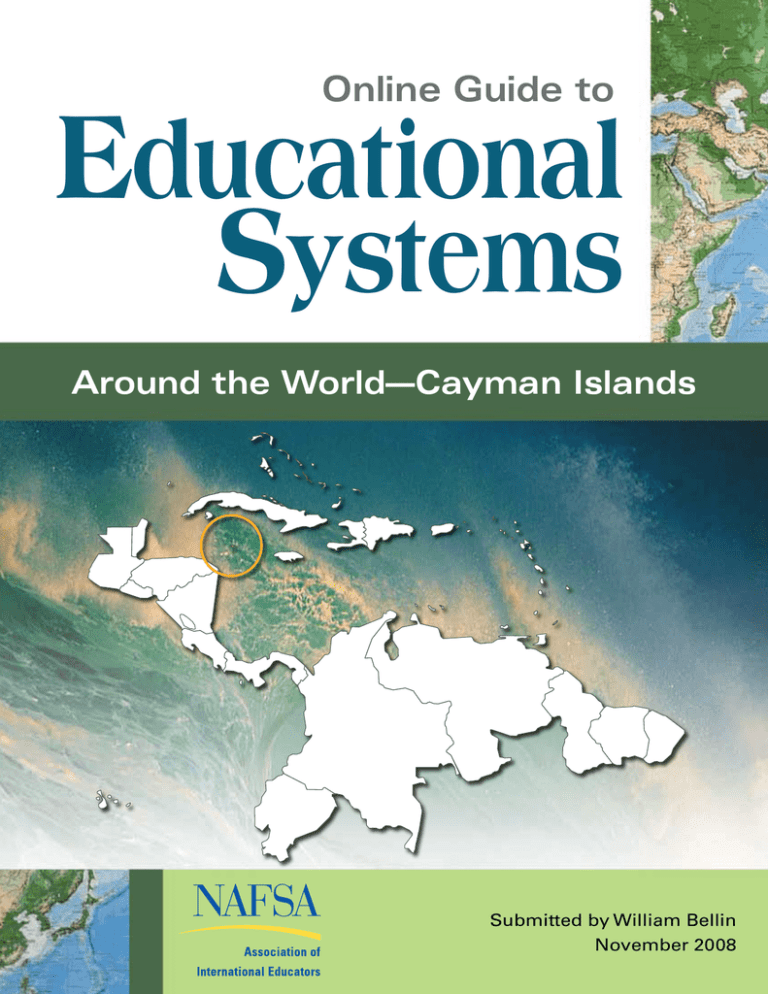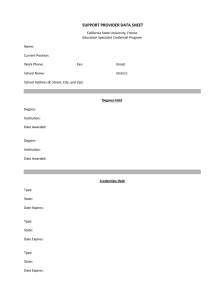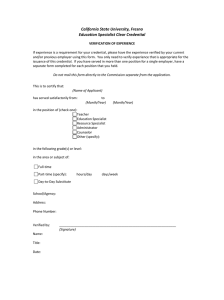
Online Guide to
Educational
Systems
Around the World­—Cayman Islands
Submitted by William Bellin
November 2008
About NAFSA
NAFSA: Association of International Educators promotes the exchange of students and scholars to and
from the United States. The association sets standards of good practice and provides professional
education and training that strengthen institutional programs and services related to international
education and exchange. NAFSA provides a forum for discussion of issues and a network for sharing
information as it seeks to increase awareness of and support for international education in higher
education, in government, and in the community.
In 1948, NAFSA pioneered the concept of providing professional services for postsecondary exchange
students. Early efforts to enhance living and learning environments for exchange students have
blossomed into today’s active association of accomplished professionals whose numbers continue to
grow worldwide.
Notice of Liability
The information in these documents is distributed on an “As is” basis, without warranty. While every
precaution has been taken in the preparation of each document, neither the submitter(s) nor NAFSA
shall have any liability to any persons nor entity with respect to any loss or damage caused or alleged
to be caused directly or indirectly by the information contained in any of these documents. Please note
that while NAFSA periodically verified the Web site links included in these e-Publications, NAFSA
cannot guarantee that every link will be current at the time of download.
Acceptable Use Guidelines
Electronic resources are provided for the benefit of the international education community. However,
commercial use, systematic or excessive downloading, or electronic redistribution of these publications
are all expressly prohibited.
© 2009 NAFSA: Association of International Educators. All rights reserved.
1
Online Guide to Educational Systems Around the World
Instructions for Using the Online Guide to
Educational Systems Around the World
Susan Whipple, Editor
December 2008 These documents are updates to those in the 1999 publication A Guide to Educational Systems
Around the World (which was an update to The Handbook on the Placement of Foreign Graduate
Students, published in 1990 and colloquially known as the "Graduate Handbook.")
It is important to note that these documents do not replace either of the earlier
publications, which should be used for credentials issued prior to 1999, the period those
publications cover.
Readers familiar with the original version of A Guide to Educational Systems Around the World
will note that these updates use the same format:
1. Each of these publications provides lists of credentials and other data that can be used
both for undergraduate and graduate admissions.
2. "Advice for admissions officers" is intentionally not provided. We have attempted to
avoid all types of subjective interpretation, relying instead on objective data. Users of
these updates should use the information provided in conjunction with other resources
to determine their own placement recommendations and possibility of transfer credit.
Questions about credentials can be posted on the Admission and Credential Evaluation
discussion forum on the Recruitment, Admissions, and Preparation Knowledge
Community Web site:
http://www.nafsa.org/knowledge_community_network.sec/recruitment_admissions/
admissions_and_credential/forums.
Please note that these updates should be supplemented by additional written materials that
describe complete foreign educational systems, including data on specific institutions, and by
professional training in the theory and practice of credential evaluation. Many of these resources
are available from NAFSA, either as printed publications or on-line. The need for institution
support for budgetary resources and training for undergraduate and graduate admissions
personnel remains important, regardless of the increased availability of resources on the Web.
These publications were compiled by many authors using a standardized template and style.
Although minor variations among entries do occur, the basic guidelines are explained as follows:
Educational Ladder
Online Guide to Educational Systems Around the World
2
The year or half-year at which a credential is awarded is the point at which the corresponding
credential letter is placed. In the example above, credential A is awarded after the 9th year of
education. Note that the corresponding letter is placed directly below the number 9.
All normal possibilities of the total number of years of education that a credential might require
are indicated on the ladder. This occurs for credential B, in which the credential can be awarded
after either 12 or 13 total years of education. An explanation is provided in the description of the
credential whenever a letter appears on the ladder more than once. There are a few cases when
this multiple-listing style was not used; in these cases, there are explanatory comments.
An arrow (Æ) is used after a credential letter in cases where no maximum length of study for a
particular program is specified, or where the study time is open-ended. For example, a doctor of
philosophy degree program may require a minimum of three years of enrollment. The
corresponding credential letter with an arrow will appear under the minimum number of total
years of education required to earn the Ph.D.
Explanations About Documents
Credentials are divided into two categories: secondary and postsecondary. The decision to
include the credential under one or the other category is not a subjective one—a credential is
determined to be either secondary or postsecondary according to its designation by the country of
origin, regardless of how individual institutions might perceive the level (and recommend transfer
credit).
Numerical endnotes, placed directly after the complete list of credentials, are used when a
lengthy explanation about a credential is necessary.
Foreign Terms and Words
Foreign terms are used whenever possible, and are translated literally, in most cases. Literal
translations are used to avoid subjectivity. We have attempted to be consistent with translations
across languages, though readers may notice some differences between countries because of
preferences indicated by the submitters. Credential evaluators and admissions personnel should
always rely on official foreign language documents, using translations only as guides.
Grading lnformation
Only the most common grading scales used in each country are listed. Evaluators understand
that variations in grading are common and that one should always consult the grading information
that may be provided on official transcripts. Rather than making grade equivalency statements,
the submitter(s) of the update provided information regarding grading practices within the
countries.
3
Online Guide to Educational Systems Around the World
CAYMAN ISLANDS
YEARS OF EDUCATION
1→6 │
A
7 │ 8 │ 9 │ 10 │ 11 │ 12 │ 13 │ 14 │ 15 │ 16 │ 17 │ 18 │ 19 │ 20 │ 21 │ 22 │ 23 │ 24
B
E
F
K
M
C
F
G
L
N
D
H
J
I
CREDENTIALS OR DOCUMENTATION
Secondary
A Cayman's 11+ Examination throughout grades 4-6; provides access to secondary
education
B Caribbean Secondary Education Certificate (CSEC): awarded by the Caribbean
Examinations Council (CXC)
C General Certificate of Education (GCE), Ordinary Level: awarded by various
examination boards, including the University of Cambridge Local Examinations
Syndicate and the University of London; see United Kingdom for grading
information
D General Certificate of Secondary Education (GCSE) or International General
Certificate of Secondary Education (IGCSE): awarded by various examination
boards, including the University of Cambridge, showing at least five subjects
passed; see United Kingdom for grading information
E High School Diploma awarded by John Gray High School
F Caribbean Advanced Proficiency Examinations (CAPE): awarded by the Caribbean
Examinations Council (CXC); requires credential B or equivalent for admission;
Certificate following a one-year program and successful completion of one unit;
Diploma following a two-year program and successful completion of six units
G General Certificate of Education, Advanced Level: awarded by various examination
boards, including the University of Cambridge Local Examinations Syndicate and
the University of London; two-year program following credential B; see United
Kingdom for grading information
Postsecondary
H Certificates awarded by University College Cayman Islands (UCCI): one-year
programs, admission requires two examination passes from credential B or
equivalent; provides access to credential J programs
I Professional Program Certificate, in Legal Secretarial, Vocational Paralegal,
Cayman Banking, or Management Practice, awarded by UCCI: part-time programs
of varied duration; admission based on three examination passes from credential B
or equivalent, or employment experience, or a combination of examinations and
employment
J Associate's degrees (Associate of Arts, Associate of Sciences, and Associate of
Applied Science) awarded by UCCI: two-year programs requiring credential B or
equivalent for admission
K Bachelor's degrees awarded by UCCI: four-year program requiring credential B or
equivalent for admission, or two-year program following credential J
L Bachelor of Education degree in Elementary or Secondary Education: four-year
Online Guide to Educational Systems Around the World
4
M
N
program requiring credential B or equivalent for admission, or two-year program
following credential J
Postgraduate Diploma in Education in Elementary and Secondary Education
awarded by UCCI: one-year program requiring credential K or equivalent for
admission
Master's degree in Human Resource Management awarded by UCCI: 14-month
program requiring credential K or equivalent for admission
GRADING SCALES
Secondary
Caribbean Examinations Council: until June 1998
Grade
Description
I
Comprehensive working knowledge of the syllabus
II
working knowledge of most aspects of the syllabus
III
working knowledge of some aspects of the syllabus
IV
limited knowledge of a few aspects of the syllabus
V
insufficient evidence on which to base a judgement
Caribbean Examinations Council: since June 1998
Grade
Description
I
comprehensive grasp of the principles, concepts and skills contained in
the syllabus
II
good grasp of the principles, concepts and skills contained in the syllabus
III
fairly good grasp of the principles, concepts and skills contained in the
syllabus
IV
moderate grasp of the principles, concepts and skills contained in the
syllabus
V
limited grasp of the principles, concepts and skills contained in the
syllabus
VI
very limited grasp of the principles, concepts and skills contained in the
syllabus
Caribbean Advanced Proficiency Examination
Grade
Description
I
represents an excellent performance
II
represents a very good standard of performance
III
represents a good standard of performance
IV
represents a satisfactory standard of performance
V
represents an acceptable level of performance
VI
represents weak performance
VII
represents unsatisfactory performance
The CAPE examinations use seven overall grades: I, II, III, IV, V, VI, VII in reporting
candidate's overall results along with the profile grades, A, B, C, D, E, F and G.
Postsecondary: University College of the Cayman Islands
Letter Points Percentage Descriptor
A
4.00
85-100
Outstanding
B+
3.50
80-84
Very good
B
3.25
75-79
Good
5
Online Guide to Educational Systems Around the World
BC+
C
CD
F
3.00
2.50
2.25
2.00
1.00
0.00
70-74
65-79
60-64
55-59
45-54
0-44
Above average
Satisfactory
Average
Below average
Unsatisfactory
Failure
POSTSECONDARY INSTITUTION RECOGNITION BODIES
The Community College of the Cayman Islands was established on the basis of the
Community College of the Cayman Islands Law of 1987. By legislative act in 2005
(known as the University College Law), the Community College of the Cayman Islands
was renamed as University College of the Cayman Islands. For further information
regarding the University College Law, refer to:
http://www.radiocayman.gov.ky/pls/portal30/docs/FOLDER/SITE83/GAZETTES/GS2005
/GS672005.PDF
Caribbean Accreditation Authority for Education in Medicine and other Health
Professions (CAAM-HP) was established in 2003 to accredit medical, dental, veterinary,
and other health professions education programs leading to professional degrees
required for practice in the Commonwealth Caribbean. Institutions offering these
programs in the Cayman Islands are subject to accreditation by CAAM-HP. For
accreditation status of institutions visit http://www.caam-hp.org
RESOURCES FOR ADDITIONAL INFORMATION
Caribbean Examinations Council: http://www.cxc.org
Cayman Islands Education Department for Primary and Secondary Education:
http://www.italic.ky/lv/Dep/school.nsf/HomePage/Welcome
Commonwealth Universities Yearbook. 81st ed. Volume 2. London: The Association of
Commonwealth Universities, 2007.
Meditz, Sandra W. and Dennis M. Hanratty, editors. Caribbean Islands: A Country
Study. Washington: GPO for the Library of Congress, 1987.
http://countrystudies.us/caribbean-islands/
Ministry of Education: http://www.brighterfutures.gov.ky
Steward, Lucy, and Elwyn Thomas. Teacher Education in the Commonwealth. London:
Commonwealth Secretariat, 1996.
University College of the Cayman Islands: http://www.ucci.edu.ky
Submitted by
William Bellin
Educational Credential Evaluators, Inc.
November 2008
Online Guide to Educational Systems Around the World
6


